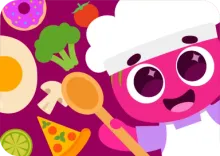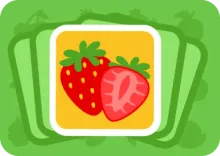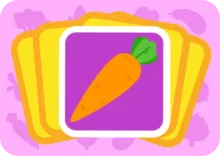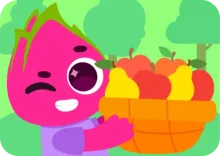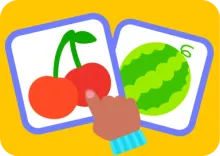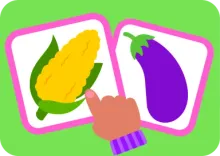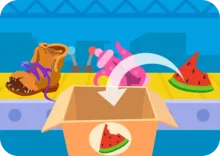Food games for kids – tasty, fun, and educational
Food games make kids curious about ingredients, meals, and healthy habits through play. These activities support vocabulary, sorting, and simple decision-making while keeping learning practical and enjoyable.
Table of contents
- Food games to learn meals and choices
- Benefits of playful food activities
- Types of food games
- Easy food games for toddlers
- Kitchen games with practical learning
- Learning food games for kids
- Food games for parties
- Apps and gadgets for food games
- Food games for kids with special needs
- Food games on recycling & sustainability
- How to organize food play time

Food games for kids to learn about meals and choices
For parents, no question is more timeless than: “How do I get my child to eat?” Some kids are picky, some are suspicious of food, some refuse to try anything new, and some want nothing but pasta… For adults, every breakfast, lunch, or dinner can feel like a quest or a challenge. But what if food and the process of discovering it became an exciting game? Food games for kids are not just a way to entertain a kid – they are a powerful tool for developing healthy eating habits, broadening horizons, and stimulating a range of cognitive skills. These include a wide collection of cooking games, toddler games, and other interactive activities designed to engage and educate.
This article will show how food play can become your ally in the kitchen and at the table, turning disliked foods into objects of exploration and fun. We will explore a variety of fun food games for kids, including cooking games and toddler games, that can help overcome food aversions, develop fine motor skills, stimulate sensory perception, and even introduce basic math concepts.
Play even with food: what’s the benefit of these activities?
We all remember the strict childhood rule: “Don’t play with your food!” But what if that’s not true? Using food in play is much more than just a distraction during mealtime. It’s a purposeful educational approach that helps achieve several important developmental goals through food activities for kids, covering various aspects of child development:
- Development of healthy eating habits and overcoming pickiness. When food becomes part of a game, pressure decreases and fear of new products disappears. Children begin to see food as something to explore rather than something mandatory. This helps expand their diet and foster a love for healthy food.
- Sensory development. Food is a rich source of sensory experiences. Food play allows children to explore textures, smells, tastes, colors, and shapes. It stimulates all five senses and helps develop the ability to distinguish textures, aromas, and flavors.
- Fine motor skills and hand-eye coordination. Handling small pieces of food (for example, sorting berries, creating patterns with vegetables, kneading dough) requires precise finger and hand movements, promoting fine motor skills and coordination. Later on, even holding a fork or spoon becomes a motor skill exercise.
- Cognitive development. Educational food games for kids are used to learn colors, shapes, counting, sorting, and categories (fruits, vegetables, grains). Children learn to classify, compare, and solve simple logical problems.
- Creativity and imagination. Creating edible pictures, shapes from dough, or unusual sandwiches enhances creativity and imagination, turning ordinary food into works of art.
Involving the child in the cooking process (under adult supervision) and preparation for the game teaches responsibility and independence. The earlier children learn the basics of cooking and lose their fear of the kitchen, the easier it becomes for them to be self-reliant.

Help your child
grow with Keiki
We’ll help you turn everyday screen time into real learning progress.
Try KeikiTypes of food games – from kitchen play to developmental activities
Food games for kids offer a huge variety of formats – from interactive cooking sessions to fun educational challenges.
Easy food games for toddlers – first steps in tasty play
Introducing food games to toddlers is the perfect way to spark their curiosity about healthy eating and the world of food. At this age, little ones are eager to touch, taste, and explore, making simple games a fun and effective teaching tool. Try “Pancake Faces,” where kids can decorate their own pancakes with colorful fruits, vegetables, and other tasty toppings. This game not only encourages creativity but also helps toddlers become familiar with different foods and textures.
Another favorite is “Letter of the Week,” where you and your child pick a letter and find foods, fruits, or vegetables that start with it. For example, during “B week,” you might serve bananas, blueberries, and broccoli, turning every meal into a playful learning experience. These easy food games are a gentle introduction to cooking, eating, and making healthy choices, all while having fun together. It’s a wonderful way to begin teaching toddlers about the variety and excitement of food from the very beginning.
Practicality above all: games for kids in the kitchen
These activities turn the kitchen into a play zone. Kids can grab, catch, or throw food items as part of the game mechanics, making the kitchen a dynamic play zone. Who said games only belong in the playroom? The kitchen is an almost endless source of ideas that, from an early age, teach practicality and useful self-care skills, while also allowing children to learn from each mistake during cooking activities.
Culinary detective
Blindfold your child and invite them to guess a food item by its smell or taste. This develops the sense of smell and taste receptors. It’s also a way to “re-discover” foods the child previously rejected. If your child makes a mistake while identifying the food, that's part of the fun and helps them learn through trial and error.
Fun sorting
Lay out various fruits, vegetables, or pasta on the table. Ask your child to grab and catch different food items as they sort them by color, shape, size, or category (fruits/vegetables). Great for developing logic and classification skills.
Edible pictures
Use different pieces of fruit, vegetables, cheese, or bread to create funny faces, animals, or patterns on a plate. Kids can also use sauces to decorate their creations, and add toppings to cakes, donuts, or cupcakes as part of the activity. This helps develop motor skills and creativity – and keeps the child engaged while you cook or do the dishes.
Young baker
Involve your child in kneading dough (for cookies, pizzas, cakes, cupcakes), shaping rolls, or forming edible figures. Baking is a key part of the activity – together you can bake cakes, cupcakes, and pizzas, or prepare fries and hamburgers. It’s not only fun but also introduces the basics of cooking.
Fruit skewers
Invite your child to thread pieces of various fruits onto skewers to create colorful and healthy desserts. This develops motor skills and teaches color combinations. After making the skewers, kids can feed their creations to family members or enjoy feeding themselves.
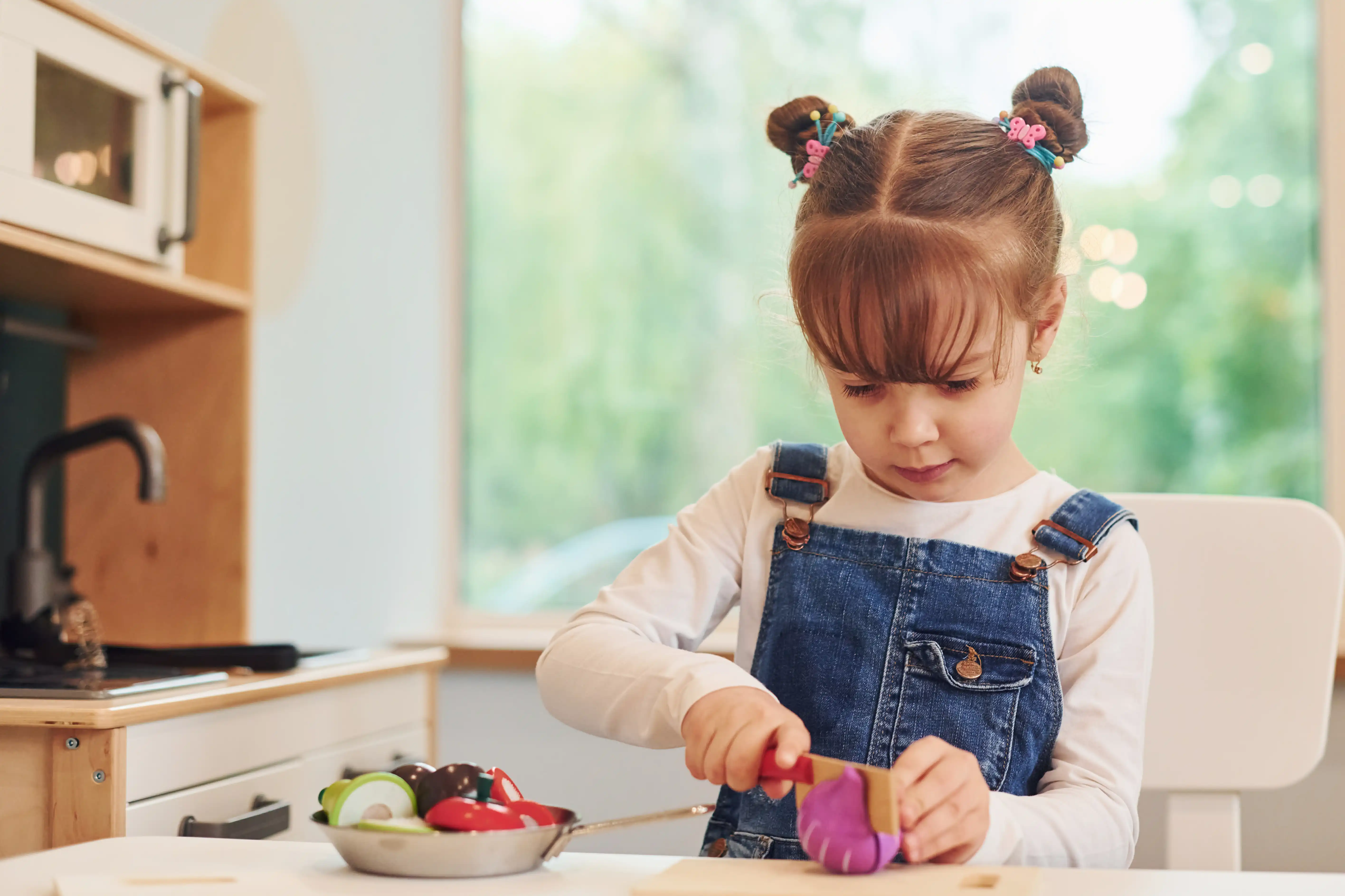
Learning food games for kids – learn and taste more
These games use food as a tool for learning and cognitive development. It becomes more than just a source of energy or new tastes – it becomes a means to teach.
Blind taste test
Blindfold your child and let them try different foods, asking them to identify the taste (sweet, sour, salty, bitter). You can add a surprise element for older kids.
Count the peas
Use beans, peas, or pasta to practice counting, create patterns based on samples, or solve simple math tasks. Children can keep score as they count peas or solve math problems, turning the activity into a fun game where they try to beat their previous score.
Guess the smell
Fill small containers with different items (cinnamon, lemon, coffee, vanilla) and ask your child to identify them by smell. This also helps expand vocabulary.
The journey of food
Discuss where different foods come from (garden, store, farm). It broadens a child’s worldview and understanding of the environment. Learning about the journey of food helps children make better choices in real life, as they can apply this knowledge when selecting and preparing meals outside of the game. It’s one of the fun ways to teach kids about food and gives a powerful boost to development.
Food quiz
Ask questions about the benefits, properties, and origins of different foods. For example: “Which fruit is red and round?” Encourage children to answer these questions, and let them win small rewards for each correct answer.
Help your child thrive with playful learning
Turn screen time into real growth with Keiki’s educational games.
Try KeikiFood games for parties – group fun and celebration
When it’s time to celebrate, food games bring extra fun and laughter to the table for the whole family. These games are perfect for birthday parties, family gatherings, or any event where kids and adults want to play together. One crowd-pleaser is the “Ice Cream Sundae Relay,” where players race to collect all the items needed to build the perfect sundae, from sprinkles to chocolate sauce. The excitement builds as everyone tries to complete their creation first!
Another hilarious option is “Whipped Cream Hide-and-Seek.” Hide small treats under piles of whipped cream and let kids compete to find them – using only their mouths! These food games are not just about eating; they’re about teamwork, friendly competition, and making sweet memories. Whether you’re planning a big party or a simple family night, these games guarantee fun for kids and the whole family, with plenty of delicious options to enjoy.
Interactive support: how apps and gadgets can help with food games
Washing the kitchen, shopping for groceries, finding the time and patience – it’s all possible, but not always within reach. That’s when various apps come to the rescue, offering just as many opportunities. Some apps are developed by specific developers who may include ads to support the app or offer in-game purchases for extra features. Among them is Keiki, where you can find games to teach kids about healthy eating that directly and indirectly help explore the topic:
- Product names. In an interactive game format, children visually learn the names of popular foods. Word-learning games are powerful tools on their own, but in Keiki, they go even further. The child takes on the role of a chef’s assistant, choosing the right ingredients from a list for cooking. All of this is accompanied by animations, bright characters, and illustrations.
- Matching and memory games. Flashcards and memory games featuring food images help with name recognition, visual memory, and attention.
- Fruits and vegetables. In a quest-style format, children collect popular fruits and vegetables, getting to know them while training attention skills.
- Flashcards. One of the best-known methods for learning new words and improving memory. Keiki offers specific card sets by category, such as fruits.
- “Green habits.” Practical kitchen skills go beyond cooking and knowing ingredients – they also include ecology, waste disposal, and mindfulness. The app includes games on these topics, helping children build awareness from an early age.
Keiki offers creative food play ideas in a safe, ad-free environment with offline use capability. There are also other apps that offer recipes suitable for young children – safe, simple, and accessible.
Related Games in Keiki App
Food games for kids with special needs – inclusive and accessible play
Every child deserves the chance to join in the fun, and food games can be adapted to suit kids of all abilities. Inclusive food games are designed to be accessible, ensuring that everyone can participate and enjoy the experience of cooking and playing with food. “Sensory Bin Exploration” is a wonderful game where kids can touch, smell, and explore different foods – like rice, beans, or soft fruits – at their own pace, making it ideal for children with sensory sensitivities.
“Adaptive Cooking” is another great option, where kids use special tools or receive extra support to help them add ingredients, mix, or decorate dishes. These games can be played at home, in school, or during therapy sessions, making cooking and food play a joyful, shared experience. By focusing on fun and participation, these food games help every child feel included, confident, and excited to explore the world of food.
Green bites: food games about recycling and sustainability
Teaching kids about healthy eating goes hand-in-hand with lessons on caring for the planet. Green bites food games are a fun way to introduce children of all ages to recycling, sustainability, and mindful eating. Try a “Recycling Relay,” where kids race to sort food packaging and other materials into the correct recycling bins. It’s a fast-paced game that teaches important lessons about waste and the environment.
“Sustainable Cooking” is another engaging activity, where kids learn to use leftovers, choose seasonal vegetables, and reduce food waste while preparing a meal. These games make learning about sustainability interactive and memorable, showing kids that every small action – like composting fruit peels or reusing containers – can make a big difference. By playing these food games, children develop healthy eating habits and a lifelong respect for the world around them, all while having fun and enjoying delicious food.
How to organize the perfect time for “edible” games?
To ensure food games are as beneficial and safe as possible, follow these recommendations:
- use safe and age-appropriate foods – choose items that are easy to chew. Prioritize foods that don’t trigger allergies. Always supervise young children during activities;
- maintain hygiene – wash hands before and after food play. Don’t forget to clean up the workspace and utensils after the activity. If food won’t be eaten immediately, store or dispose of it properly;
- create a clean workspace – for kitchen games for kids, use a plastic sheet, large tray, or play mat to minimize mess;
- encourage exploration, but not waste – allow your child to explore food, but also explain the value of food and the importance of treating it respectfully;
- inspire and join the process – show your interest in food, cook together, try new things. Children learn by imitating adults;
- decorate plates – use cookie cutters to make fun shapes from fruits and vegetables, and try other creative ideas to make the plate and its contents more appealing;
- involve them in food prep – even toddlers can help rinse vegetables, tear lettuce, or stir ingredients. For portion control or sharing, let your child practice dividing food in half;
- narrate everything you do – even if it feels odd to comment on every step, naming foods and tools, describing the color of vegetables, the sharpness of a knife, or the crinkle of a bag, it becomes a huge source of new information for the child.
At the end, praise your child if they try a new food or show interest in eating.

